
Sharm el Sheikh VS Dahab: Where’s best in Egypt for your Red Sea diving?
Sharm el Sheikh VS Dahab: Which town in Egypt is best for your Red Sea diving? Here, we’ll compare the diving, the vibes, and the logistic of these two dive hubs on the Sinai peninsula. So what are you waiting for? Let’s dive in!
WHY DIVE IN EGYPT
Egypt’s Red Sea is one of the closest places to Europe for a dive trip. Direct flights to dive destinations and excellent tourist infrastructure make the Red Sea a hassle-free destination for your next dive trip.
And the diving is truly excellent. From deep canyons to rich marine biodiversity and historical shipwrecks, there’s so much to discover! The water is (mostly) warm, with excellent visibility. And there’s tons of wildlife to spot, making it interesting for novice and experienced divers alike.
Top tip: If you’re looking to learn to dive through an Open Water Certification, Sharm El Sheikh in Egypt is one of the cheapest places in the world to do this.
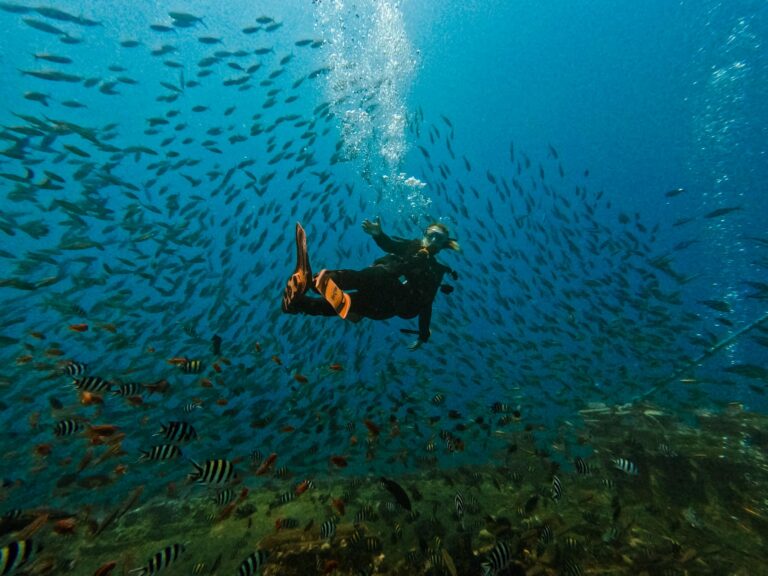
Diving in Egypt is incredible!
OVERVIEW: SINAI REGION
But why Choose Sinai Over Other Places in the Red Sea? Well, it’s not just Sharm el Sheikh vs Dahab. you could also head to Hurghada or Marsa Alam. But with its backdrop of deep turquoise ocean against the golden rocky desert mountains, the Sinai Peninsula is a pretty unique destination for your next dive trip. It’s a world away from the hustle, bustle and scam culture you’ll find across the rest of Egypt.
In addition to the scenery, the wildlife here is incredible. Underwater protected areas such as the Ras Mohammed National Park provide a safe haven for creatures of all sizes. You’re just as likely to spot tiny nudibranchs as you are to swim alongside dolphins and sharks.
The dive sites are varied too! There are underwater canyons, drop-offs and caves to swim through. Artificial reefs have been created allowing corals to thrive on sculptures – there’s even a giant coral elephant (seriously, it’s like an underwater museum). And, if that isn’t quite selling it to you, the Sinai Peninsula is home to the best wreck dive in the world: the SS Thistlegorm.

Sinai has unique scenery, it’s pretty special
SHARM EL SHEIKH VS DAHAB: WHICH IS THE BEST BASE FOR DIVING?
There are two main towns to use as a base for your Red Sea adventures in Sinai: Dahab and Sharm El Sheikh. Although these towns are just 90 kilometres apart, the vibes are completely different.
So, Sharm el Sheikh vs Dahab? Which town you’ll find ‘best’ depends on your budget and travel style, but we’ve written this article to help you figure it out. Ready? Let’s go!
SHARM EL SHEIKH
THE VIBE IN SHARM EL SHEIKH
Sharm El Sheikh is known for being a luxury diving destination. The town is renowned for its expensive and often all-inclusive resorts, offering high-end accommodations, spas, and fine dining. If you’ve got cash to splash and want your every need catered for, Sharm is the dive destination for you!
With an international atmosphere, Sharm El Sheikh is full of European and US tourists, much more so than the smaller town of Dahab. Because of this, it’s a very safe place to travel to; most resorts go above and beyond to ensure high security. If you’re travelling with children, Sharm el Sheikh might be a good option for you.
If you like to party, the town has a vibrant nightlife scene, with clubs, bars, and entertainment options. And if you like your home comforts when you travel, you’ll be able to find familiar international restaurants and shops in Sharm too.
However, it’s important to note that Sharm El Sheikh is a town created entirely for resort tourism. There aren’t very many local people here, except those working in the tourism and hospitality industry. This can make Sharm feel a little soul-less as there’s little to no history or culture here.

Smaller resorts in Sharm el Sheikh
DIVING IN SHARM EL SHEIKH
DIVE SITES:
Sharm El Sheikh has some of the best dive sites in the world. The town is super close to the Ras Mohammed National Park and just a few hours by boat from the wreck of the SS Thistlegorm. These sites are known for their incredible marine biodiversity and you’ll have ample opportunity to spot rare wildlife.
GETTING SCUBA CERTIFIED:
Sharm boasts numerous dive centres, making it an excellent choice to do your PADI or SSI Open Water certification. You’ll probably be able to learn in your preferred language too. However, certifications will likely cost more here than they do in Dahab due to the ‘upmarket’ nature of the town.
BOAT VS SHORE DIVING:
Most of Sharm’s top dive sites are best reached by boat: you can’t really dive from the shore. Boats leave in the morning and arrive back in the late afternoon. Perhaps not the best if you get seasick, or want to do more on your trip than just dive.
COSTS:
Because of this, diving in Sharm el Sheikh is inherently more expensive than diving in Dahab, where most dives are done from the shore.
As the area caters to luxury and resort tourism, equipment hire can also be expensive, depending on where you stay and which dive company you choose. National Park permits ($8 USD/day) for Ras Mohammed can also add to the costs of your diving.
MARINE LIFE:
There’s so much to see here! Wildlife around Sharm el Sheikh is abundant due to the town’s proximity to the stunning protected reef in the Ras Mohammed National Park. This provides better variety for new and experienced divers alike.
You have a larger chance of spotting big wildlife, such as dolphins, sharks, turtles, and moray eels, but there’s everything from large fish to tiny nudibranchs. It was in the Ras Mohammed protected area that I fulfilled my childhood dream of swimming alongside dolphins (ethically of course).
Oh, and the SS Thistlegorm wreck… where do I even start? There were more fish here than I’ve ever seen together in one place. Seriously, it was like swimming in an aquarium! A truly magical experience for sure.
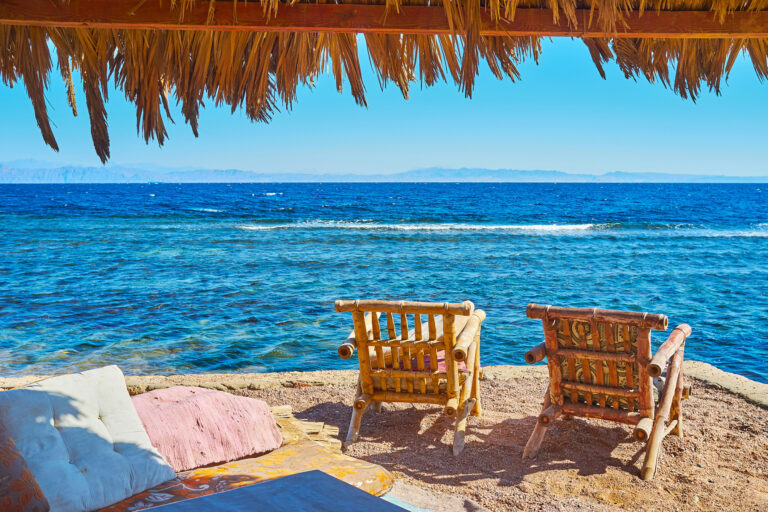
Chilling out at beach cafes in Dahab
DAHAB
THE VIBE IN DAHAB
The laid-back diver’s Paradise of Dahab is just 90 kilometres (55 miles) north of Sharm el Sheikh, but it feels like a world away. Known for its cosy bohemian atmosphere, Dahab has a chilled-out, magical charm that it’s impossible not to fall in love with.
The scenery in Dahab is pretty special. Goats roam the town like a reckless band of pirates, foraging for plants and garbage. Rocky mountains rise immediately behind the down, contrasting with the calm turquoise ocean. You can even see Saudi Arabia in the distance if the weather isn’t too hazy
You can walk from one end to the other of this charming, small coastal town in around 20 minutes, but that doesn’t mean there’s a shortage of things to do. There are quirky restaurants and numerous wooden beachfront cafes extending out over the ocean (often these have private beaches for customers). And, of course, there’s diving and snorkelling too.
Don’t worry. Dahab is still very much a tourist town, with hotels, guesthouses, shops, and restaurants. But the dive scene here sprang up around an existing town, and you’ll find Dahab more aligned with the Egyptian lifestyle. Lots of Egyptians live, work, vacation, and even ‘digital nomad’ here.
The Bedouin community and hospitality you’ll find in Dahab is a lovely and calm contrast to the rest of Egypt. The people are kind, and are more likely to invite you in for a cup of tea and to share some sweets than they are to scam you into paying extortionate prices for cheap souvenirs and average food.
Now I don’t want to be biased. But if I was going to move to any place to dive long-term, Dahab would be it. So, Sharm el Sheikh vs Dahab, let’s jump into the dive comparison.
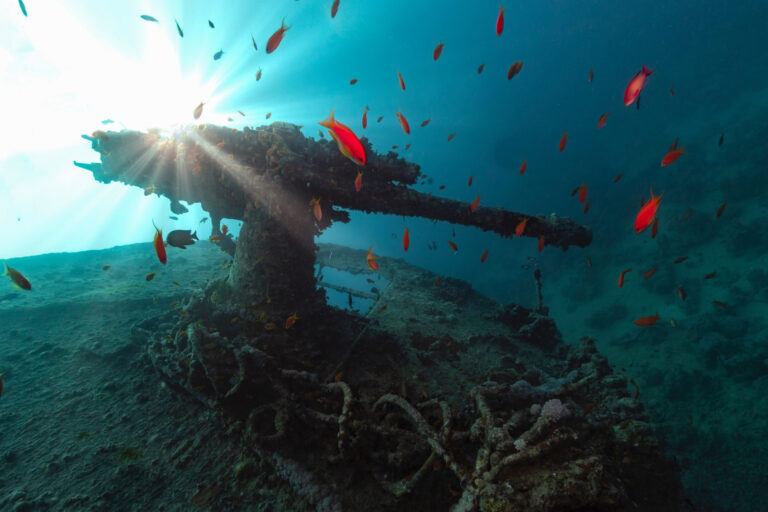
Diving the SS Thistlegorm – an experience you don’t want to miss!
DIVING IN DAHAB
DIVE SITES:
Dahab is known for iconic dive sites such as the Blue Hole, the Canyon, and the Lighthouse Reef. The Blue Hole, in particular, is a bucket-list dive, with a deep underwater arch and rich marine life. Divers with a technical diving certification will enjoy the challenges the dive sites around Dahab have to offer, the town being a well-known hub for technical diving.
One particular experience unique to Dahab is ‘camel diving’ in Ras Abu Galum. Divers flock here for baby triggerfish and schools of needlefish, and the experience is (so far) untouched by mass tourism. Heading north of Dahab on a camel, you’ll ride, dive, and repeat, eventually setting up camp under the stars with your Bedouin guides.
Most of the dive sites in and around Dahab are just a short drive away. If you are travelling to Egypt with a group and you don’t all dive, you may find Dahab a better compromise as you have the option of doing just one dive per day, and spending the rest of the day with the group.
The drawback? Dahab doesn’t have any underwater national parks or protected areas. That said, it is only an hour by car to Sharm el Sheikh. If you want to dive at the Ras Mohammed National Park, or the Thistlegorm Shipwreck, it’s a long day, but easily arranged.
GETTING SCUBA CERTIFIED:
Dahab is also an excellent choice to do your PADI or SSI Open Water certification. Like Sharm el Sheikh, there are more dive centres here than you could shake a stick at. And the international vibe of Dahab means that you can also learn to dive in multiple languages, including English, German, French and Russian.
BOAT VS SHORE DIVING:
Unlike Sharm el Sheikh, many of Dahab’s dive sites are accessible from the shore, making it convenient for multiple dives per day without long boat trips. You just pull on your gear and walk right in. I get seasick, so shore diving is perfect for me. But walking with your equipment on can be exhausting after a few dives, and requires a base level of fitness.
Between dives, there’s usually a Bedouin café or restaurant to chill out. The Bedouin culture in Egypt is unique to Sinai, so this is a great opportunity to soak it all up.
COSTS:
You’ll find Dahab cheaper than Sham el Sheikh. This is partly because the town caters less to luxury resort travel, but also because most of the dives are from the shore. This reduces the need for divers to pay towards a boat and crew.
We did 6 dives in Dahab and 3 dives in Sharm el Sheikh, all organised through SlyDive Dahab. The dives in Dahab cost ~30 EUR per dive including all equipment hire and were all shore dives. The dives in Sharm el Sheikh cost 70 EUR each, and included boat, equipment, and National Park fees.
MARINE LIFE:
Someone call Pixar, and tell them not only have we found Nemo, we’ve found Dory too!
Jokes aside, the wildlife in Dahab is similar to Sharm el Sheikh. There are corals and seagrass, along with the usual small to medium fish you usually find in these habitats. We saw unicornfish, clownfish (they’re so sassy!), boxfish and cleaner fish. Jokingly referred to as ‘Egyptian dental care’, the cleaner fish will dart inside your mouth if you stay still and remove your regulator, which is a fun experience.
Our divemasters also had seen turtles, dolphins, and stingrays in and around Dahab’s dive sites. Unfortunately, we didn’t encounter any larger marine life in Dahab. Perhaps if we stayed longer…
Looking for BIG wildlife? Here are our guides to:
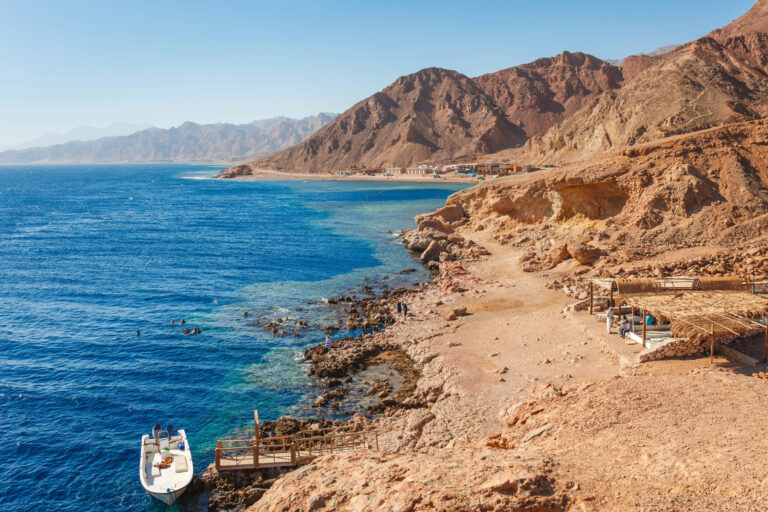
Blue Hole and Canyon dive sites
SHARM EL SHEIKH VS DAHAB: LOGISTICS
Currently citizens of the United Kingdom, all European Union countries, and the United States can visit Sinai for up to 14 days without a visa. This makes visiting Dahab and Sharm el Sheikh an easy and hassle free option if you’re looking for a diving holiday.
Sharm el Sheikh is, logistically, easier to get to. The town has its own international airport, and your accommodation can easily organise airport transfers. Your resort or hotel is also likely to have its own dive centre, making organising your dives a breeze. Although this does come at a cost. When comparing Sharm el Sheikh vs Dahab, Sharm el Sheikh is, overall, more expensive.
Dahab is a little further afield. It’s around a one-hour taxi from Sharm el Sheikh international airport, which you’ll have to organise through your accommodation or haggle on arrival. Finding a dive centre in advance can be difficult. Some larger hotels have their own dive centres, but most dive centres don’t treat you as a customer unless you’re standing there in person. Just turn up. Egyptians are some of the most hospitable people we’ve met. They’ll always find a space for you, even if they’re busy.
Dahab is also set up for remote working – perfect for digital nomads! It’s very normal to see Egyptians and non-Egyptians with their laptops at the beach or in a cafe and there are a bunch of co-working spaces.
VISITING THE REST OF EGYPT?
The only drawback of visiting Sinai is that it’s a real trek from the rest of Egypt. The peninsula has little Ancient Egyptian history. If the Great Pyramids of Giza, Valley of the Kings, and the Temple of Abu Simbel are on your bucket list, then you’re looking at a nine-hour drive to Cairo, or a less-sustainable but quicker two-hour flight to Cairo or Luxor.
Those looking to visit the rest of Egypt on a short time frame may wish to look into diving in Marsa Alam or Hurghada, which are much closer to the historic sites.
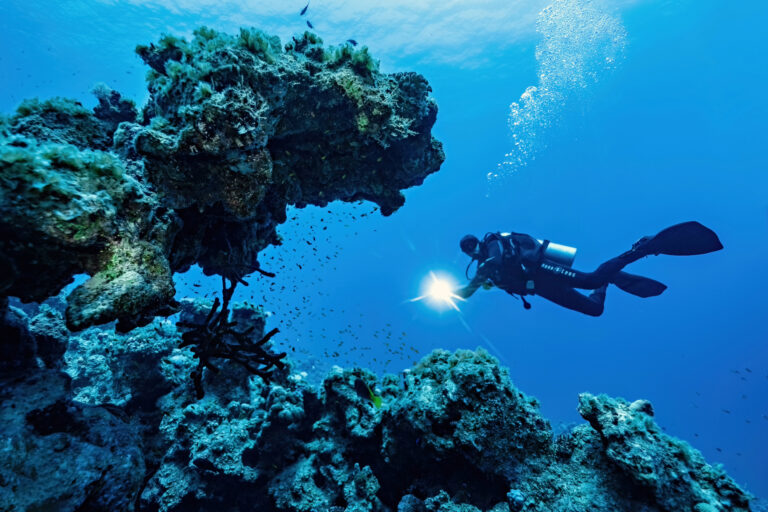
Typical diving in Sharm el Sheikh and Dahab
AN ALTERNATIVE: LIVEABOARD DIVING
We can’t speak about this personally, but a third option for diving in Sinai is booking a Liveaboard! Liveaboard dive ships in Egypt offer an immersive diving experience, allowing divers to explore dive sites across the Red Sea that aren’t limited to Sinai.
Yes, you’ll get to dive the famous Sinai sights: the Canyon, Blue Hole, Ras Mohammed National Park, and SS Thistlegorm wreck. But after a few days, you’ll sail south to explore the Central and Southern Red Sea, including Elphinstone Reef.
Liveaboard dive ships run to their own schedule, meaning you’ll have a better chance of diving without other groups on site. You’ll also increase the possibility of seeing bigger marine life, such as sharks, dolphins, and turtles.
The drawback is that depending on the level of luxury you’re looking for, liveaboard dive experiences can get very expensive.
A NOTE ON SUSTAINABLE DIVING
In Dahab especially, the accessibility of diving comes with a price. The Lighthouse dive site is getting trashed by divers. As this site is so close to the town, snorkellers also flock here, and many restaurants and cafés accidentally pollute the ocean with trash.
The Canyon dive site is on its way to being trashed by divers too, so it’s important to practice sustainable and reef-friendly diving.
Here are our top tips for sustainable diving in Dahab:
#1 GOOD DIVE PRACTICES
Don’t ever forget the basics from your Open Water course. Check your buoyancy before you descend and practice good buoyancy control throughout your dive. This will prevent you from damaging coral reefs and stirring up sediment, which can impact wildlife.
Oh, and if that doesn’t convince you, good buoyancy means that you use your body less to stay afloat. This lowers your air consumption, so you’ll get longer dives from a single tank!
#2 RESPECT & DON'T TOUCH
You should always keep away from any wildlife you encounter in the water – that includes fish, sharks, dolphins, turtles. Never try to touch them, chase them, or ride them (yep… there are people who would try that). Let them approach you if they are curious, but you’ll probably find that they’re not bothered.
Don’t touch the corals either! Corals have delicate structures and can easily break or crumble when touched. Corals also have a protective coating, and the oils and bacteria in your skin can remove this which makes them more vulnerable. Once a coral is damaged, it can take a while to grow back. So best not to touch them at all.
And lastly, help to conserve the biodiversity and beauty of the reef. Don’t litter. Collect any trash that you do see in the water to take back and dispose of. Never collect anything from the reef, such as shells or coral, as a souvenir – there might be an animal inside! As the saying goes, ‘leave only footprints and take only photos’
#3 AVOID WEARING SUNSCREEN
Caring for your skin is important. But if you’re going to go diving in Sinai, you need to stay clear of the sunscreen or make sure you choose reef-safe sunscreen that’s 100% biodegradable! Coral reefs are dying, species are disappearing at an alarming rate, and while this isn’t entirely down to your choice of sun protection, the chemicals in sunscreen are super hazardous to ocean wildlife. Wear a t-shirt instead!
You shouldn’t use any other oils or lotions either. Scientists say that environmental contaminants in your favourite skincare products can be just as damaging.
#4 CHOOSE SUSTAINABLE DIVE OPERATORS
When choosing a dive company, look for an operator with a clear commitment to protecting the environment. Some dive companies state their policies towards sustainable and eco-friendly diving on their websites. But eco-friendly and sustainable diving could also look like:
- A dive instructor or divemaster who looks out for, and corrects divers who are not practicing good buoyancy
- Dive centres that brief divers on eco-friendly and responsible diving alongside the generic pre-dive brief
- Smaller dive groups, which are easier to monitor
- Dive centres that has environmental practices, such as using resuables instead of single-use plastic between dives and minimising water and electricity consumption
- Enforcing the use of reef-safe sunscreen or providing full-length wetsuits or rash guards as alternative sun protection.
- A company that supports marine conservation and scientific research projects
- The boats you dive from use mooring buoys instead of anchoring on the seabed.
- Employing local people and not relying on international dive instructors
#5 JOIN A REEF CLEANUP
Want to dive for free? Some dive shops in Dahab organise weekly cleanup dives to remove debris and litter from the ocean. By joining these, the cost of your dive will be reduced, it may even be free, and you’ll be helping to remove trash from the ocean. Talk about a win-win scenario!
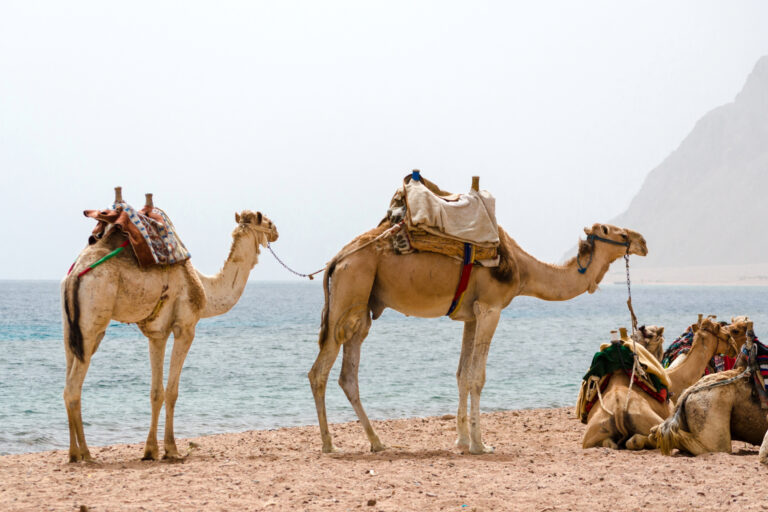
Camel diving: Ride, Dive, Repeat
SHARM EL SHEIKH VS DAHAB: THE VERDICT
So, Sharm el Sheikh vs Dahab: where’s best for your Red Sea diving?
Well, this depends entirely on your travel style. Personally, I travel on a budget, and whilst I don’t try and save money at the expense of not enjoying my travels, I can’t justify splashing out on luxury hotels. I also don’t love all-inclusive resorts. They’re great for a day’s relaxation, but after a couple of days, I’m desperate to escape the confines of the hotel.
This meant that, for us, Dahab was the ideal choice. Budget-friendly, a little hippie, with cool people, great food options and cheap diving… we couldn’t fault it. You might like Sharm but you can fall in love with Dahab.
That said, if you’re looking for a more luxury experience, an ‘easier’ holiday, booking a dive resort hotel in Sharm el Sheikh could be worth looking into. We think Sharm is also a great choice for those travelling with family or children, as hotels can arrange activities to suit everyone – it just might not come cheap!
OTHER THINGS TO DO IN SINAI
It’s not just diving! Here’s our list of other amazing things to do in Sinai, which you’ll be able to arrange throug your accommodation or your dive centre:
1.
Hiking Mount Sinai (Jabal Musa): Mount Sinai is a holy mountain across Judaism, Islam, and Christianity, where the prophet Moses is said to have received God’s 10 Commandments. Trek to the summit to witness breathtaking sunrise views and visit the historic St. Catherine’s Monastery.
2.
Exploring Colored Canyon: North of Dahab, the coloured canyon is a sandstone canyon, where mineral deposts create beautiful patterns. Embark on a guided hike through this stunning canyon with vibrant hues of red, orange, and yellow rock formations.
3.
Camel Trekking in the Desert: Experience the traditional Bedouin way of travel with camel rides through the vast desert landscapes of Sinai. Why not combine a camel trek with diving in the Ras Abu Galum protected area?
4.
Camping in the Desert: What could be better than visiting a traditional Bedouin camp for the night. Marvel at the clear night skies and millions of stars visible in the remote desert areas of Sinai.
5.
Visiting St. Catherine’s Monastery: Explore one of the oldest Christian monasteries in the world, located at the base of Mount Sinai, housing ancient manuscripts and religious artifacts.
6.
Rock Climbing and Bouldering: The rugged cliffs and boulders of Sinai are a popular place for climbing and bouldering. Your hotel or possibly even your dive centre can organise an excursion, with various climbing routes suitable for all levels.
7.
Kiteboarding and Windsurfing: Best done near Sharm el Sheikh, this activity doesn’t come cheap. But the steady winds and calm ocean create perfect conditions for kiteboarding and windsurfing along the coast of the Sinai peninsula.
8.
Quad Biking and Desert Safari: Experience adrenaline-pumping adventures with quad biking tours, ATV tours, and off-road desert safaris across Sinai’s dunes and rugged terrain.
That’s it! We hope you found this helpful. If you’re visiting Egypt, here are some posts you might find helpful to read before you go.
And as always, leave your comments or questions below! It would really make my day to hear from you.
LIKE IT? PIN IT!
SAVE THIS POST TO YOUR PINTEREST BOARD TO COME BACK LATER
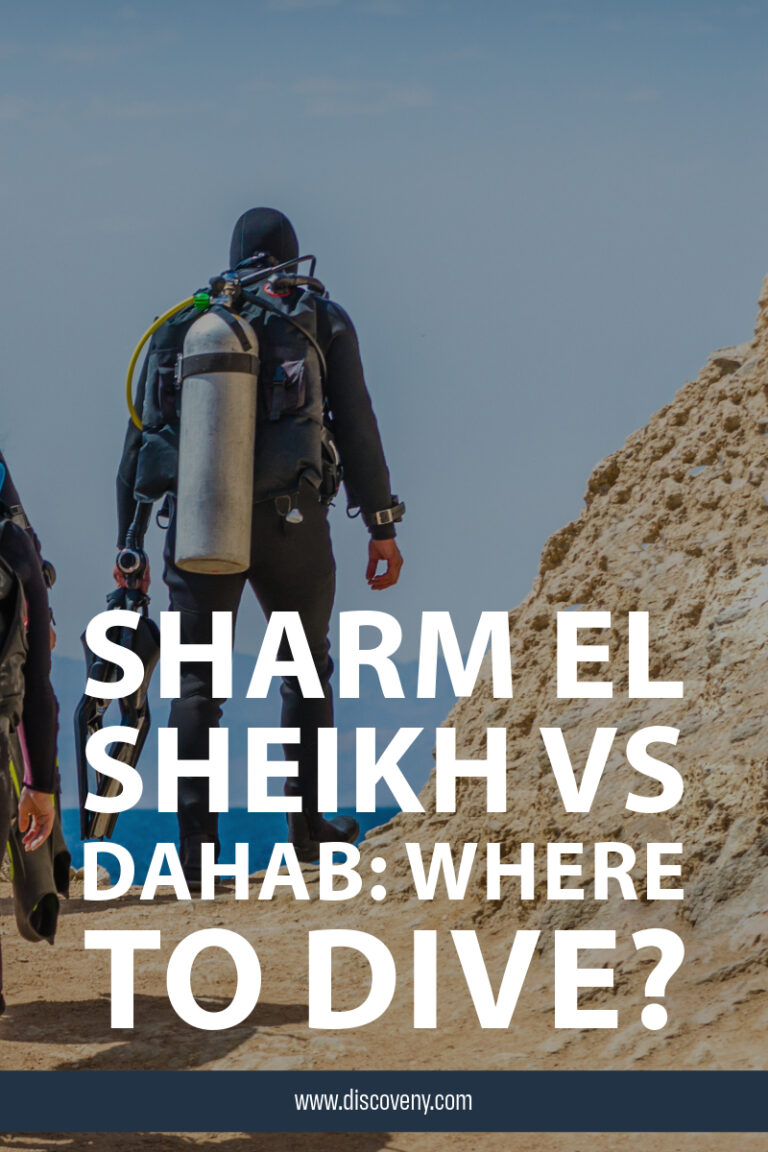
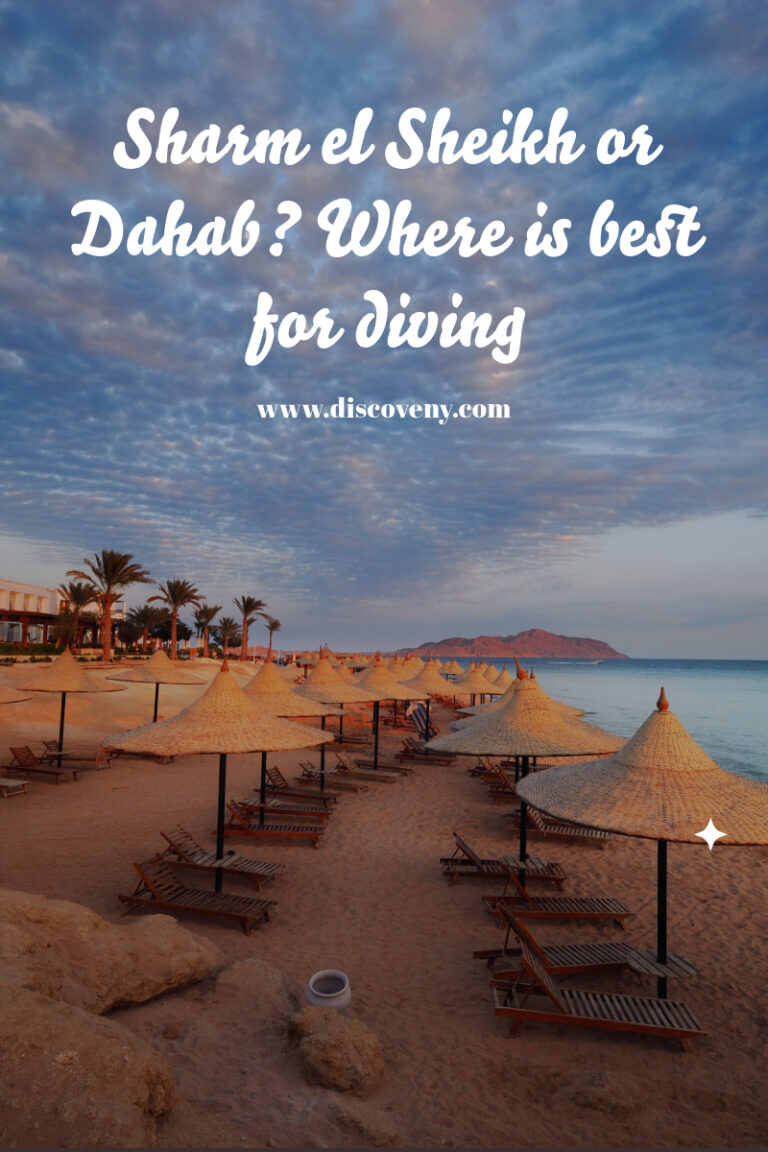
Follow our daily adventures on Facebook and Instagram
Disclaimer: The information and advice provided in this blog are the author’s opinions and based on their personal experiences. All information was accurate at the time of writing. However, things can change quickly, so always double-check current conditions and guidelines before setting out. Remember, your travels and safety are your own responsibility, and this blog can not be held responsible for anything that might happen on your adventures! Always exercise caution and good judgment. Oh, and don’t forget to get travel insurance! Happy travels!
This post may contain affiliate links (yay for transparency!) This means that I will earn a small commission, at no additional cost to you, if you click the link and choose to buy the product. I only link to stuff I have personally bought and found useful and never endorse crap. Your support helps keep the site going, thank you!
Alice
Alice is a UK travel blogger who advocates sustainable travel and being more eco-conscious on a budget. She loves coffee, her houseplants and summiting mountains.
You May Also Like
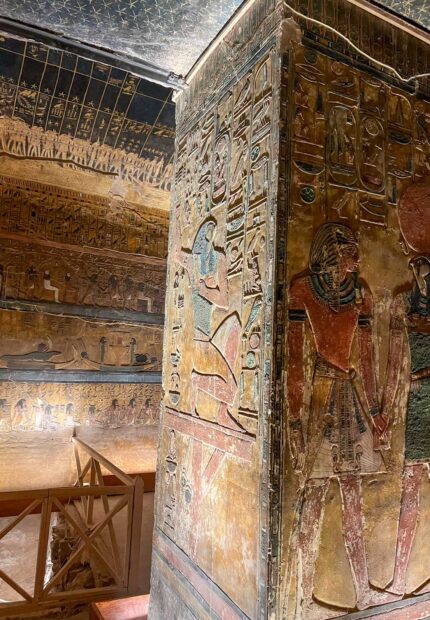
Tomb of Seti I: Is it worth the money?
July 13, 2024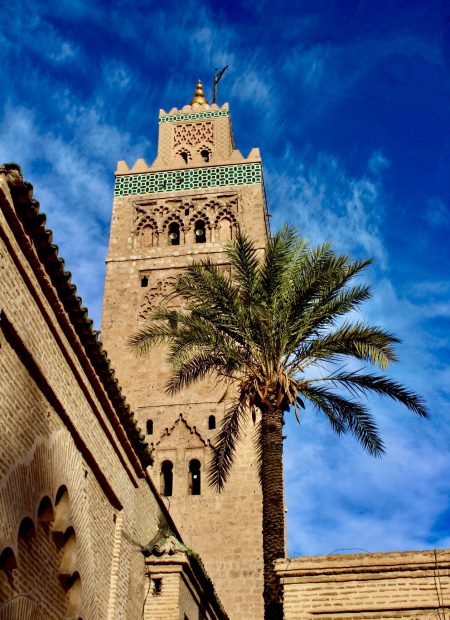
Female Traveller in Morocco – What’s It Really Like?
November 14, 2020